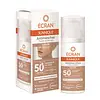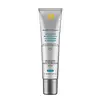What's inside
What's inside
 Key Ingredients
Key Ingredients

 Benefits
Benefits

 Concerns
Concerns

 Ingredients Side-by-side
Ingredients Side-by-side

Water
Skin ConditioningDibutyl Adipate
EmollientEthylhexyl Salicylate
UV AbsorberButyl Methoxydibenzoylmethane
UV AbsorberTitanium Dioxide
Cosmetic ColorantBis-Ethylhexyloxyphenol Methoxyphenyl Triazine
Skin ConditioningButyloctyl Salicylate
Skin ConditioningEthylhexyl Triazone
UV AbsorberSodium Stearoyl Glutamate
CleansingDiethylhexyl Butamido Triazone
UV AbsorberGlyceryl Stearate
EmollientC12-15 Alkyl Benzoate
AntimicrobialChlorella Vulgaris/Lupinus Albus Protein Ferment
Skin ConditioningNasturtium Officinale Flower/Leaf Extract
AntiseborrhoeicNiacinamide
SmoothingSodium Tocopheryl Phosphate
AntioxidantTocopheryl Acetate
AntioxidantZinc PCA
HumectantAcrylates Copolymer
Acrylates/C10-30 Alkyl Acrylate Crosspolymer
Emulsion StabilisingAlcohol Denat.
AntimicrobialCI 77491
Cosmetic ColorantCI 77492
Cosmetic ColorantCI 77499
Cosmetic ColorantHydroxyacetophenone
AntioxidantLactic Acid
BufferingLecithin
EmollientOctyldodecanol
EmollientParfum
MaskingPhenoxyethanol
PreservativePotassium Sorbate
PreservativeShorea Robusta Resin
TonicSilica
AbrasiveSilicon
AbrasiveSodium Acrylates Copolymer
Sodium Benzoate
MaskingDisodium EDTA
Water, Dibutyl Adipate, Ethylhexyl Salicylate, Butyl Methoxydibenzoylmethane, Titanium Dioxide, Bis-Ethylhexyloxyphenol Methoxyphenyl Triazine, Butyloctyl Salicylate, Ethylhexyl Triazone, Sodium Stearoyl Glutamate, Diethylhexyl Butamido Triazone, Glyceryl Stearate, C12-15 Alkyl Benzoate, Chlorella Vulgaris/Lupinus Albus Protein Ferment, Nasturtium Officinale Flower/Leaf Extract, Niacinamide, Sodium Tocopheryl Phosphate, Tocopheryl Acetate, Zinc PCA, Acrylates Copolymer, Acrylates/C10-30 Alkyl Acrylate Crosspolymer, Alcohol Denat., CI 77491, CI 77492, CI 77499, Hydroxyacetophenone, Lactic Acid, Lecithin, Octyldodecanol, Parfum, Phenoxyethanol, Potassium Sorbate, Shorea Robusta Resin, Silica, Silicon, Sodium Acrylates Copolymer, Sodium Benzoate, Disodium EDTA
Water
Skin ConditioningAlcohol Denat.
AntimicrobialEthylhexyl Triazone
UV AbsorberDrometrizole Trisiloxane
UV AbsorberIsononyl Isononanoate
EmollientIsopropyl Lauroyl Sarcosinate
Skin ConditioningButyl Methoxydibenzoylmethane
UV AbsorberDiisopropyl Sebacate
EmollientBis-Ethylhexyloxyphenol Methoxyphenyl Triazine
Skin ConditioningNiacinamide
SmoothingDimethicone
EmollientMethylene Bis-Benzotriazolyl Tetramethylbutylphenol
UV FilterOctocrylene
UV AbsorberPropanediol
SolventEthylhexyl Salicylate
UV AbsorberCetearyl Alcohol
EmollientSilica
AbrasiveTranexamic Acid
AstringentTocopherol
AntioxidantPhenoxyethanol
PreservativePEG-10 Dimethicone
Skin ConditioningCI 77891
Cosmetic ColorantPolyglyceryl-10 Laurate
Skin ConditioningSodium Stearoyl Glutamate
CleansingCaprylyl Glycol
EmollientButylene Glycol
HumectantCetearyl Glucoside
EmulsifyingMica
Cosmetic ColorantGlycerin
HumectantPEG-20
HumectantAmmonium Acryloyldimethyltaurate/Vp Copolymer
Trisodium Ethylenediamine Disuccinate
Carbomer
Emulsion StabilisingInulin Lauryl Carbamate
Emulsion StabilisingT-Butyl Alcohol
PerfumingWater, Alcohol Denat., Ethylhexyl Triazone, Drometrizole Trisiloxane, Isononyl Isononanoate, Isopropyl Lauroyl Sarcosinate, Butyl Methoxydibenzoylmethane, Diisopropyl Sebacate, Bis-Ethylhexyloxyphenol Methoxyphenyl Triazine, Niacinamide, Dimethicone, Methylene Bis-Benzotriazolyl Tetramethylbutylphenol, Octocrylene, Propanediol, Ethylhexyl Salicylate, Cetearyl Alcohol, Silica, Tranexamic Acid, Tocopherol, Phenoxyethanol, PEG-10 Dimethicone, CI 77891, Polyglyceryl-10 Laurate, Sodium Stearoyl Glutamate, Caprylyl Glycol, Butylene Glycol, Cetearyl Glucoside, Mica, Glycerin, PEG-20, Ammonium Acryloyldimethyltaurate/Vp Copolymer, Trisodium Ethylenediamine Disuccinate, Carbomer, Inulin Lauryl Carbamate, T-Butyl Alcohol
Ingredients Explained
These ingredients are found in both products.
Ingredients higher up in an ingredient list are typically present in a larger amount.
Alcohol Denat. is an alcohol with a denaturant property. It is created by mixing ethanol with other additives.
This ingredient gets a bad rep because it is irritating and drying - mostly due to its astringent property. Astringents draw out natural oils in tissue, constricting pores and leaving your skin dried out.
However, alcohol denat. is not all that bad.
Due to its low molecular weight, alcohol denat. tends to evaporate quickly. One study on pig skin found half of applied alcohol evaporated in 10 seconds and less than 3% stayed on skin.
This also helps other ingredients become better absorbed upon application.
Studies are conflicted about whether this ingredient causes skin dehydration. One study from 2005 found adding emollients to propanol-based sanitizer decreased skin dryness and irritation. Another study found irritation only occurs if your skin is already damaged.
Small amounts of alcohol are generally tolerated by oily skin or people who live in humid environments.
The rule of thumb is if this alcohol is near the end of an ingredients list, it will probably not affect your skin much.
Also...
This ingredient has antimicrobial and solvent properties.
The antimicrobial property helps preserve products and increase their shelf life. As a solvent, it helps dissolve other ingredients.
Other types of astringent alcohols include:
Learn more about Alcohol Denat.You might know this ingredient as Tinosorb S or Bemotrizinol. It is a UV filter that covers both UVA and UVB rays.
This ingredient has two peak UV absorption peaks ( 310 and 340 nm) and is able to absorb both UV-A and UV-B rays. This ingredient works by preventing UV rays from reaching and damaging your skin.
On top of that - it is highly photostable and helps prevent the photodegration of other sunscreen ingredients such as avobenzone.
Tinosorb S is allowed in the EU, Australia, and Asia. It is close to being approved by the FDA and we'll hopefully get this ingredient in the U.S. by late 2025.
Fun fact: Tinosorb S is the most effective UV absorber at maximum concentration (measured by SPF) permitted in the EU.
This ingredient is oil-soluble, so your oil-cleansers will take this right off at night.
Learn more about Bis-Ethylhexyloxyphenol Methoxyphenyl TriazineAlso known as Avobenzone, this ingredient is a chemical sunscreen filter that provides protection in the UV-A range.
Avobenzone is globally approved and is the most commonly used UV-A filter in the world.
Studies have found that avobenzone becomes ineffective when exposed to UV light (it is not photostable; meaning that it breaks down in sunlight). Because of this, formulations that include avobenzone will usually contain stabilizers such as octocrylene.
However, some modern formulations (looking at you, EU!) are able to stabilize avobenzone by coating the molecules.
Avobenzone does not protect against the UV-B range, so it's important to check that the sunscreen you're using contains other UV filters that do!
The highest concentration of avobenzone permitted is 3% in the US, and 5% in the EU.
Learn more about Butyl MethoxydibenzoylmethaneEthylhexyl Salicylate is an organic compound used to block UV rays. It primarily absorbs UVB rays but offers a small amount of UVA protection as well.
Commonly found in sunscreens, Ethylhexyl Salicylate is created from salicylic acid and 2-ethylhexanol. You might know salicylic acid as the effective acne fighter ingredient and BHA.
The ethylhexanol in this ingredient is a fatty alcohol and helps hydrate your skin, similar to oils. It is an emollient, which means it traps moisture into the skin.
According to manufacturers, Ethylhexyl Salicylate absorbs UV wavelength of 295-315 nm, with a peak absorption at 307-310 nm. UVA rays are linked to long term skin damage, such as hyperpigmentation. UVB rays emit more energy and are capable of damaging our DNA. UVB rays cause sunburn.
Learn more about Ethylhexyl SalicylateEthylhexyl Triazone is a modern chemical sunscreen that protects from UV-B radiation.
It is the most effective of existing UV-B filters, as it provides the highest level of photo-stable absorption. It protects from the entire UV-B range (280 to 320nm), with it's highest level of protection at 314nm.
Ethylhexyl Triazone is oil soluble, oderless and colorless, which mean it is able to be incorporated into a variety of different formulations.
It is not currently available within the United States due to slow changing FDA regulations. Outside of the US, it is used in formulations at concentrations up to 5%.
Learn more about Ethylhexyl TriazoneNiacinamide is a multitasking form of vitamin B3 that strengthens the skin barrier, reduces pores and dark spots, regulates oil, and improves signs of aging.
And the best part? It's gentle and well-tolerated by most skin types, including sensitive and reactive skin.
You might have heard of "niacin flush", or the reddening of skin that causes itchiness. Niacinamide has not been found to cause this.
In very rare cases, some individuals may not be able to tolerate niacinamide at all or experience an allergic reaction to it.
If you are experiencing flaking, irritation, and dryness with this ingredient, be sure to double check all your products as this ingredient can be found in all categories of skincare.
When incorporating niacinamide into your routine, look out for concentration amounts. Typically, 5% niacinamide provides benefits such as fading dark spots. However, if you have sensitive skin, it is better to begin with a smaller concentration.
When you apply niacinamide to your skin, your body converts it into nicotinamide adenine dinucleotide (NAD). NAD is an essential coenzyme that is already found in your cells as "fuel" and powers countless biological processes.
In your skin, NAD helps repair cell damage, produce new healthy cells, support collagen production, strengthen the skin barrier, and fight environmental stressors (like UV and pollution).
Our natural NAD levels start to decline with age, leading to slower skin repair, visible aging, and a weaker skin barrier. By providing your skin niacinamide, you're recharging your skin's NAD levels. This leads to stronger, healthier, and younger looking skin.
Another name for vitamin B3 is nicotinamide. This vitamin is water-soluble and our bodies don't store it. We obtain Vitamin B3 from either food or skincare. Meat, fish, wheat, yeast, and leafy greens contain vitamin B3.
The type of niacinamide used in skincare is synthetically created.
Learn more about NiacinamidePhenoxyethanol is a preservative that has germicide, antimicrobial, and aromatic properties. Studies show that phenoxyethanol can prevent microbial growth. By itself, it has a scent that is similar to that of a rose.
It's often used in formulations along with Caprylyl Glycol to preserve the shelf life of products.
Silica, also known as silicon dioxide, is a naturally occurring mineral. It is used as a fine, spherical, and porous powder in cosmetics.
Though it has exfoliant properties, the function of silica varies depending on the product.
The unique structure of silica enhances the spreadability and adds smoothness, making it a great texture enhancer.
It is also used as an active carrier, emulsifier, and mattifier due to its ability to absorb excess oil.
In some products, tiny microneedles called spicules are made from silica or hydrolyzed sponge. When you rub them in, they lightly polish away dead skin layers and enhance the penetration of active ingredients.
Learn more about SilicaSodium Stearoyl Glutamate is an emulsifier and helps condition the skin. It is amino acid-based.
In higher amounts, it may act as a cleansing agent.
Water. It's the most common cosmetic ingredient of all. You'll usually see it at the top of ingredient lists, meaning that it makes up the largest part of the product.
So why is it so popular? Water most often acts as a solvent - this means that it helps dissolve other ingredients into the formulation.
You'll also recognize water as that liquid we all need to stay alive. If you see this, drink a glass of water. Stay hydrated!
Learn more about Water